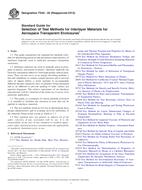We need your consent to use the individual data so that you can see information about your interests, among other things. Click "OK" to give your consent.
ASTM F942-02(2013)
Standard Guide for Selection of Test Methods for Interlayer Materials for Aerospace Transparent Enclosures
STANDARD published on 1.12.2013
The information about the standard:
Designation standards: ASTM F942-02(2013)
Note: WITHDRAWN
Publication date standards: 1.12.2013
SKU: NS-57013
The number of pages: 2
Approximate weight : 6 g (0.01 lbs)
Country: American technical standard
Category: Technical standards ASTM
The category - similar standards:
Annotation of standard text ASTM F942-02(2013) :
Keywords:
aerospace, interlayer materials, laminates, transparent enclosures, ICS Number Code 49.025.50 (Adhesives)
Additional information
| Significance and Use | ||||||||||||||||||||||||||||||||||||||||||||||||
|
3.1 This guide is intended for use by material suppliers, aircraft transparent enclosure fabricators, airframe manufacturers, government agencies, and others that may become involved in the testing of transparent interlayer materials. These test methods provide data on both individual interlayer materials and material combinations commonly used in the fabrication of aerospace transparent enclosures and provide a means of evaluating the performance of one interlayer material against another. 3.2 Primary characteristics and their long-term stability are critical to the performance of an interlayer material. Basic tests define the as-manufactured material characteristics of the interlayer material. Ageing procedures provide for representative exposure to environments that may induce changes in material characteristics. Tests performed before and after ageing exposure provide a means of estimating the potential useable life-span of an interlayer material or to compare the durability of one interlayer material with another. 3.3 When employing these test methods for the comparison of interlayer materials after exposure to selected environmental conditions, the user shall be aware that many factors influencing degradation due to weathering vary from one location and exposure period to another location and exposure period. For direct weathering comparisons, the interlayer materials to be compared shall be subjected to the exposure and have the tests performed at the same time. It is emphasized that the test values obtained under these simultaneously applied conditions are for comparative use and their use as design characteristics shall be made with caution. 3.4 The test methods listed include those considered critical to the performance of aircraft transparent enclosures. The user is advised to use the latest revision of any test method. |
||||||||||||||||||||||||||||||||||||||||||||||||
| 1. Scope | ||||||||||||||||||||||||||||||||||||||||||||||||
|
1.1 This guide summarizes the standard test methods available for determining physical and mechanical characteristics of interlayer materials used in multi-ply aerospace transparent enclosures. 1.2 Interlayer materials are used to laminate glass-to-glass, glass-to-plastic, and plastic-to-plastic. Interlayer materials are basically transparent adhesives with high-quality optical properties. They can also serve as an energy absorbing medium, a fail-safe membrane to contain cockpit pressure and to prevent entry of impact debris; a strain insulator to accommodate different thermal expansion rates of members being laminated and as an adherent to prevent spalling of inner surface ply material fragments. The relative importance of an interlayer characteristic will be a function of the prime use it serves in its particular application. 1.3 This guide, as a summary of various methods in Section 2, is intended to facilitate the selection of tests that can be applied to interlayer materials. 1.4 The test methods listed are for use in determining basic design characteristics and in assuring lot-to-lot uniformity of the materials being tested except as noted in 1.5 This standard does not purport to address all of the safety concerns, if any, associated with its use. It is the responsibility of the user of this standard to establish appropriate safety and heal practices and determine the applicability of regulatory limitations prior to use. |
||||||||||||||||||||||||||||||||||||||||||||||||
| 2. Referenced Documents | ||||||||||||||||||||||||||||||||||||||||||||||||
|
We recommend:
Updating of laws
Do you want to be sure about the validity of used regulations?
We offer you a solution so that you could use valid and updated legislative regulations.
Would you like to get more information? Look at this page.




 Cookies
Cookies
